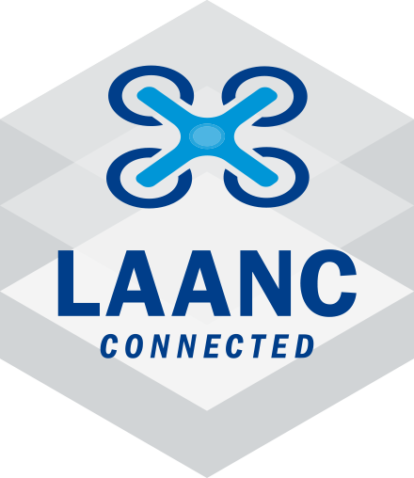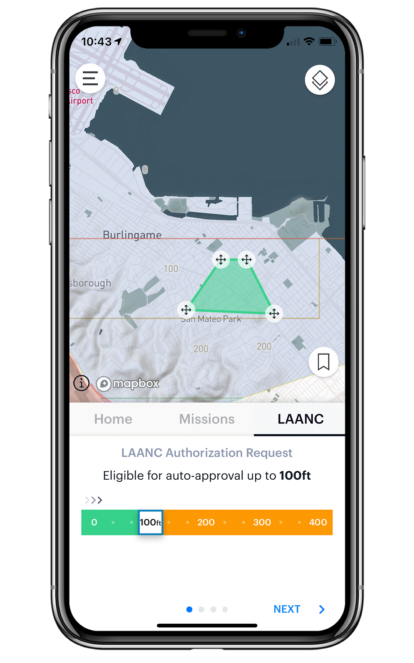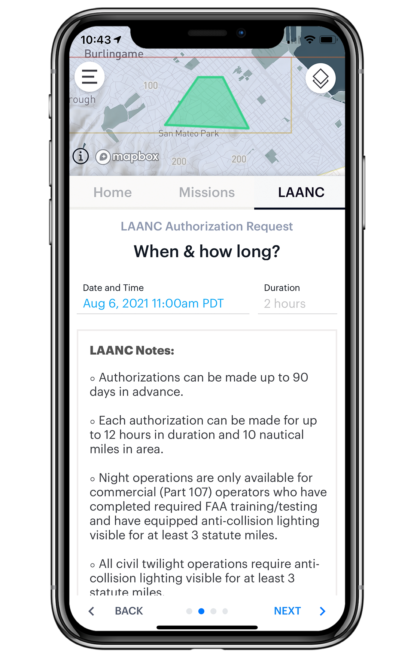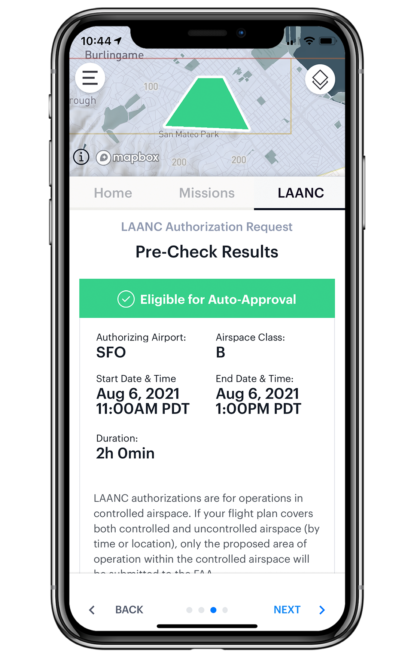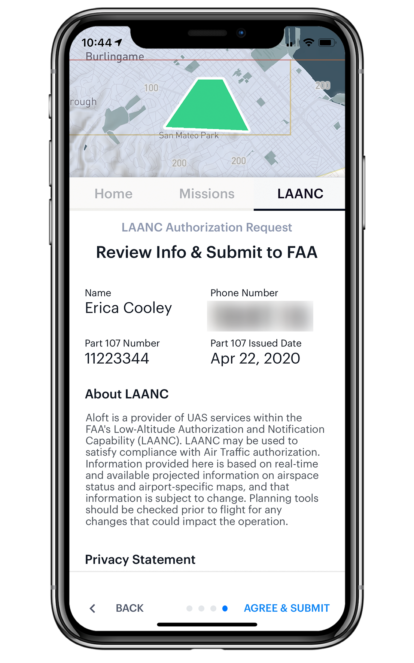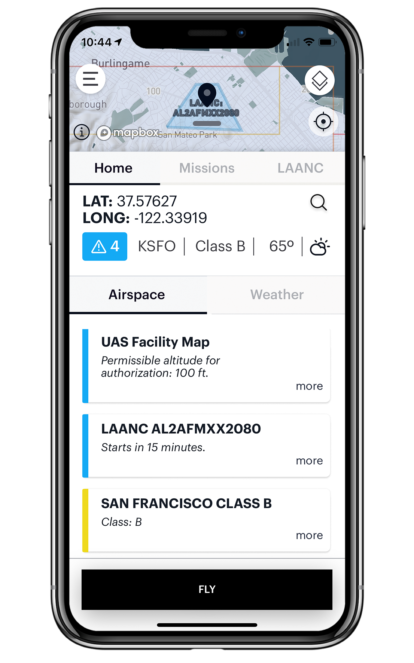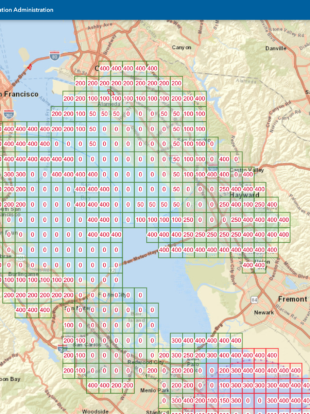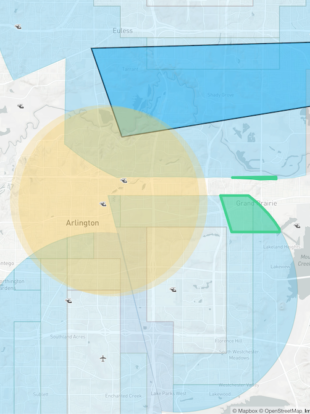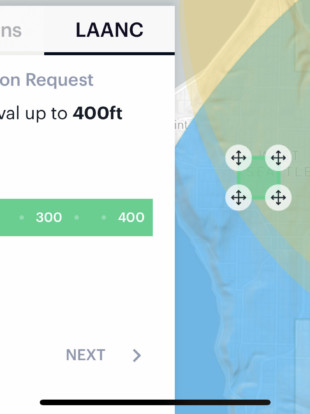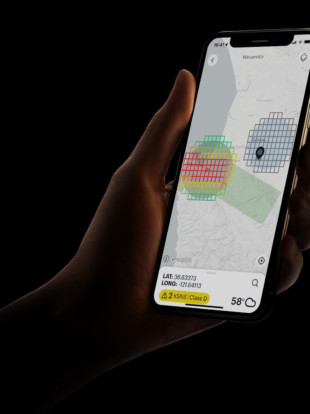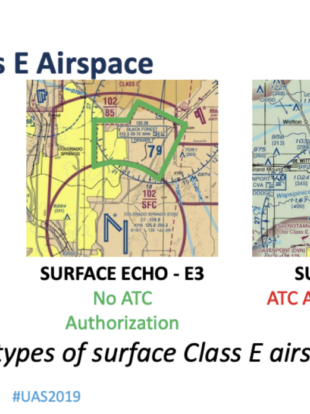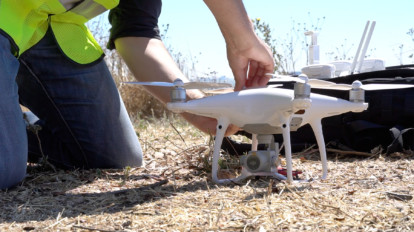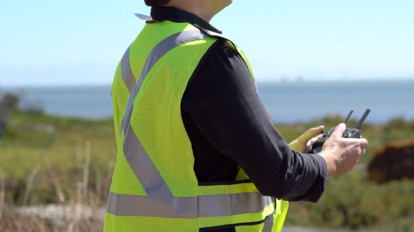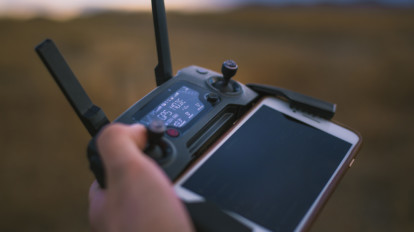What is LAANC?
LAANC is the Low Altitude Authorization and Notification Capability, a collaboration between the Federal Aviation Administration (FAA) and private industry partners. It directly supports UAS integration into the national airspace. It provides access to controlled airspace near airports through near real-time processing of airspace authorizations in approved altitudes. There are an order of magnitude more drones than manned aircraft. The existing air traffic control infrastructure was not set up to accommodate drone flights at scale. Moreover, the FAA is simply not staffed to manually approve tens of thousands of airspace authorizations. LAANC provides a framework for air traffic controllers, drone operators, and UAS Service Suppliers like Aloft to integrate into the NAS (National Airspace System).
How does it work?
LAANC automates the application and approval process for airspace authorizations. Through automated applications developed by Aloft, the leading FAA Approved UAS Service Supplier (USS), processing half of all the monthly LAANC authorizations in the US, pilots can apply for an airspace authorization. Requests are checked against airspace data in the FAA UAS Data Exchange such as the UAS Facility Maps. If approved, pilots receive their authorization in near-real-time.
How does LAANC benefit a drone pilot?
LAANC provides access for drone operators to controlled airspace around 732 airports in the US. LAANC provides even more transparency to Air Traffic Control and law enforcement in case they need to contact an operator.
Applying for LAANC on the Aloft app, pilots can:
- Receive a near real-time authorization for operations under 400 feet in controlled airspace around 732 airports.
- Commercial operators will need to apply for further coordination (requests above pre-approved ceilings) within 72 hours of desired operational start time.
- Apply up to 90 days in advance of a flight and the approval is coordinated manually through the applicable airspace owners.
- LAANC authorization areas can span up to 10 miles.
- Apply for a LAANC authorization for someone else in your organization. A UAS program manager can apply for a LAANC authorization on behalf of the UAS operator in the field who will be flying the mission, even if those people are scattered across the country. This saves time for the operator, gives a program manager a lot more flexibility to assign missions, and makes it much easier to track LAANC authorizations across an organization.
- A user can have up to five LAANC authorizations occurring during the same time period. Operations using these overlapping LAANC authorizations must be located within 100 nautical miles of one another.
- As of August 2021, commercial operators can apply for access to controlled airspace at night via LAANC.
Note: If you are planning an operation in controlled airspace that requires a waiver AND an airspace authorization you must apply for both through the FAA’s Drone Zone. Learn more about this process here.
Is LAANC available for all controlled airspace in the US?
As of March 2021, LAANC is available at 538 LAANC Enabled Facilities and 731 airports across the US. A detailed list of all the FAA facilities participating in LAANC can be found here.
How far in advance can I apply for LAANC?
Operators may submit intended operations well ahead of time (e.g. up to 90 days in advance). At a minimum, adequate time for ATC situational awareness is encouraged – for example, submitting operations at least a day or two before the operation commences. Most LAANC information exchanges occur in real-time (notifications and automatic authorizations) and provide immediate feedback to operators.
What are UAS Facility Maps (UASFMs) and how are they utilized for LAANC?
UASFMs are maps that depict pre-approved ceilings for flights in controlled airspace. UAS operators may use these altitudes as a guideline when submitting their UAS Airspace Authorization requests through LAANC.
NOTE: These maps DO NOT authorize operations in these areas at the depicted altitudes – they are for informational purposes ONLY. Operators must still apply to operate in controlled airspace (Class B, C, D, or surface-area E) by completing a Part 107 Airspace Authorization through LAANC on Aloft or completing a Waiver Application in the FAA DroneZone.
Individuals who request a part 107 airspace waiver and authorization are encouraged to consult the maps prior to submitting a request to determine locations and altitudes that can be auto-approved through LAANC. It’s important to:
- Identify permissible altitude restrictions
- Determine automated or manual authorizations
- Tailor requests to align with areas on the maps for higher chance for automated approval
Can I combine other waivers or authorizations with LAANC?
No. For example, you cannot combine a night waiver with a LAANC authorization. LAANC covers daylight operations with a hard ceiling of 400 feet, even if you are near structures greater than 400 feet. Learn more about how to apply for airspace waivers and authorizations on the FAA’s DroneZone here.
Why should I choose Aloft as my UAS Service Supplier (USS) for LAANC?
Aloft is the leading FAA-approved UAS service supplier (USS), powering 70% of the monthly LAANC authorizations in the US. Offering real-time airspace authorizations to enable flight in controlled airspace for enterprises and recreational flyers alike. For our enterprise customers, all your organization’s LAANC authorizations will automatically sync to your other logs and activity inside of Aloft Air Control, helping you plan, fly and report your organization’s compliance.
Is LAANC available for recreational flyers?
Yes, download the Aloft app today to start applying for LAANC to enable flight in controlled airspace for your recreational UAS needs.
Can I fly my drone at night in controlled and uncontrolled airspace?
Yes, on January 15, 2021, the FAA published its final rule for the Remote Identification of Unmanned Aircraft in the Federal Register which included changes to the existing requirements for operating UAS at night as well as UAS operations over people. Effective as of April 21st, 2021, all Part 107 pilots who have passed the new recurrent training course and exam are eligible to operate at night/ civil twilight in controlled airspace with a valid LAANC authorization. As of August 11th, 2021, the updated version of LAANC was released on the Aloft platform. This allows you to apply for a LAANC authorization during nighttime hours directly on the Aloft app. Watch the video tutorial or read this blog to learn more about compliantly operating a UAS at night in controlled airspace.
If your operational area is in uncontrolled airspace you do not need to apply for a LAANC authorization but you will still need to have a current Part 107 certification and completed the updated recurrent online training or have passed the Unmanned Aircraft General – Small airman knowledge test on or after April 6, 2021 and be equipped with operational anti-collision lights which can be seen for 3 statute miles and have a flash rate sufficient to avoid a collision. Download the Aloft app for free today to start enabling operations in controlled airspace at night here.
Why don't I have to apply for LAANC to operate an UAS near or around small municipal airports?
Only airports located in controlled airspace require LAANC authorizations to operate near or around. Many smaller municipal, regional, executive airports around the country are located in uncontrolled airspace meaning you do not need a LAANC authorization to operate near or around them.
According to the FAA’s statement on their website, “For [drone] flights near airports in uncontrolled airspace that remain under 400’ above the ground, prior authorization is not required.” Below are three tips to help you ensure your operation is safe and compliant while operating a UAS near an airport in uncontrolled airspace:
- When flying in these areas, remote pilots and recreational flyers must be aware of and avoid traffic patterns and takeoff and landing areas.
- A drone must not interfere with operations at the airport must yield the right-of-way to all other aircraft.
- Check the FAA’s B4UFLY app or web for specific information about the airspace you plan to operate in
